Description
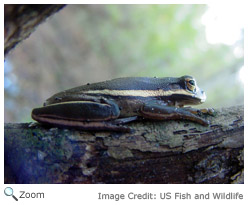 The green tree frog is 1¼ to 2½ inches long. It is bright green, greenish gray or yellow green. Its color may vary depending on temperature and activity. It is sometimes yellower when it is calling, and it may be a duller green or gray when it is cooler or when it is resting. The green tree frog is 1¼ to 2½ inches long. It is bright green, greenish gray or yellow green. Its color may vary depending on temperature and activity. It is sometimes yellower when it is calling, and it may be a duller green or gray when it is cooler or when it is resting. 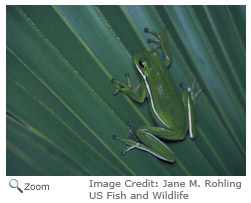
It has a light cream or green belly and it may have a light white or yellowish stripe that runs from its jaw along the side of its body. The stripe can be longer on one side of its body than it is on the other. It has long toes with big, sticky toe pads that help it cling to plants. Some green tree frogs have gold spots on their backs.
Range
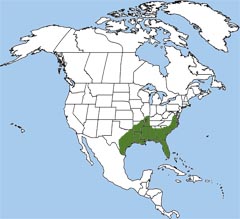 In the U.S, the green tree frog can be found along the Atlantic coastal states from Delaware to Florida, in the Gulf states, in Arkansas, eastern Texas, western Tennessee and Kentucky and parts of southern Illinois and Missouri. In the U.S, the green tree frog can be found along the Atlantic coastal states from Delaware to Florida, in the Gulf states, in Arkansas, eastern Texas, western Tennessee and Kentucky and parts of southern Illinois and Missouri.
|
|
Habitat
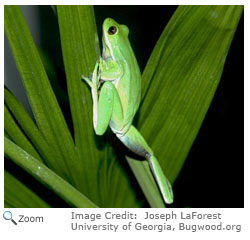 The green tree frog can be found in marshes; wet prairies; cypress swamps and along the edges of lakes, ponds and streams. It likes spots with lots of ground cover and aquatic vegetation. It often can be found among floating plants or in the vegetation around the water. It can also be found in trees and shrubs that grow near the water. During the day, it often sleeps on the undersides of leaves or in other moist, shady places. At night, it can sometimes be found looking for insects that are attracted by the lights as it clings to the window sills of houses and buildings. The green tree frog can be found in marshes; wet prairies; cypress swamps and along the edges of lakes, ponds and streams. It likes spots with lots of ground cover and aquatic vegetation. It often can be found among floating plants or in the vegetation around the water. It can also be found in trees and shrubs that grow near the water. During the day, it often sleeps on the undersides of leaves or in other moist, shady places. At night, it can sometimes be found looking for insects that are attracted by the lights as it clings to the window sills of houses and buildings.
Diet
The green tree frog eats small insects and other invertebrates.
Life Cycle
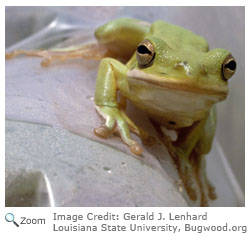 The green tree frog breeds from March to October in southern areas and from April to September in northern areas. Large groups of males, sometimes numbering in the hundreds or even thousands, will gather in breeding sites and call out to attract females. The female will lay up to 400 eggs in shallow water with aquatic plants. The males will then fertilize the eggs by discharging sperm onto them. The tadpoles hatch in about a week and become frogs in two months. The green tree frog breeds from March to October in southern areas and from April to September in northern areas. Large groups of males, sometimes numbering in the hundreds or even thousands, will gather in breeding sites and call out to attract females. The female will lay up to 400 eggs in shallow water with aquatic plants. The males will then fertilize the eggs by discharging sperm onto them. The tadpoles hatch in about a week and become frogs in two months.
Behavior
 Green tree frogs are sometimes called rain frogs. Some people think that they are good indicators of rainy weather because they call loudest during damp weather. From a long distance, the green tree frog's call sounds like a cowbell. At closer distances its call sounds more like a "quank-quank."
|
 Green tree frogs are sometimes called rain frogs. Some people think that they are good indicators of rainy weather because they call loudest during damp weather. From a long distance, the green tree frog's call sounds like a cowbell. At closer distances its call sounds more like a "quank-quank."
Green tree frogs are sometimes called rain frogs. Some people think that they are good indicators of rainy weather because they call loudest during damp weather. From a long distance, the green tree frog's call sounds like a cowbell. At closer distances its call sounds more like a "quank-quank."



 In the U.S, the green tree frog can be found along the Atlantic coastal states from Delaware to Florida, in the Gulf states, in Arkansas, eastern Texas, western Tennessee and Kentucky and parts of southern Illinois and Missouri.
In the U.S, the green tree frog can be found along the Atlantic coastal states from Delaware to Florida, in the Gulf states, in Arkansas, eastern Texas, western Tennessee and Kentucky and parts of southern Illinois and Missouri. 
